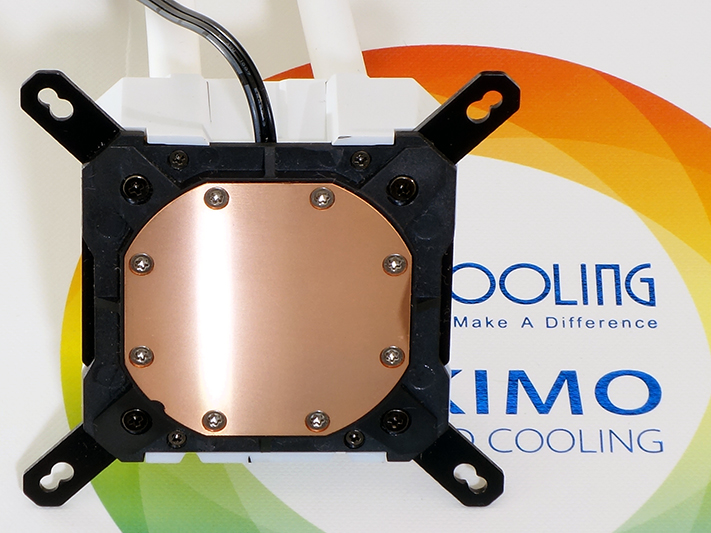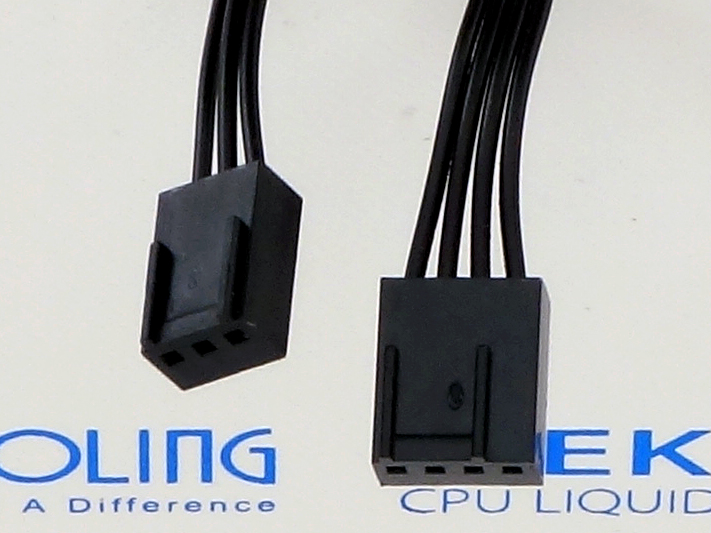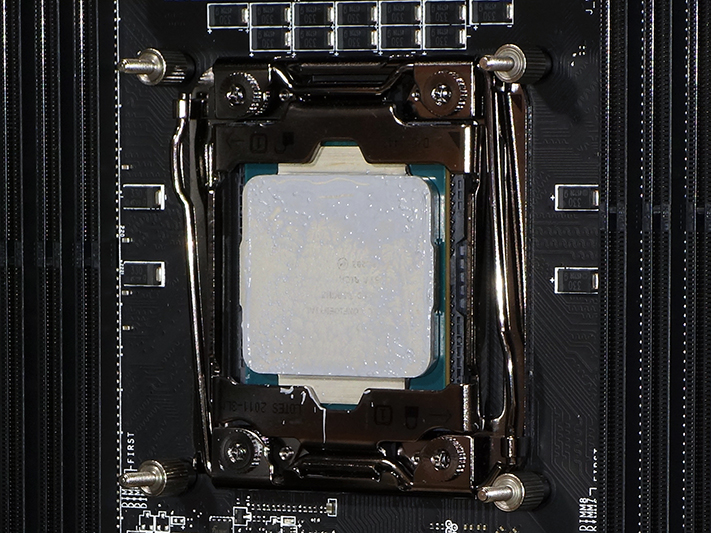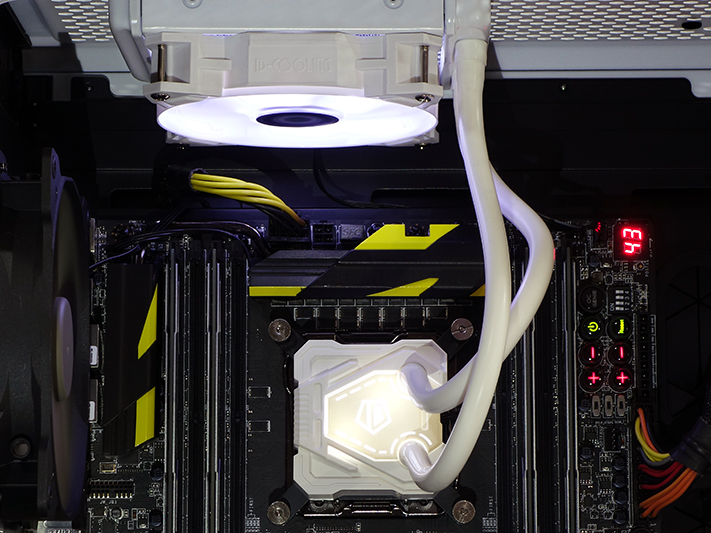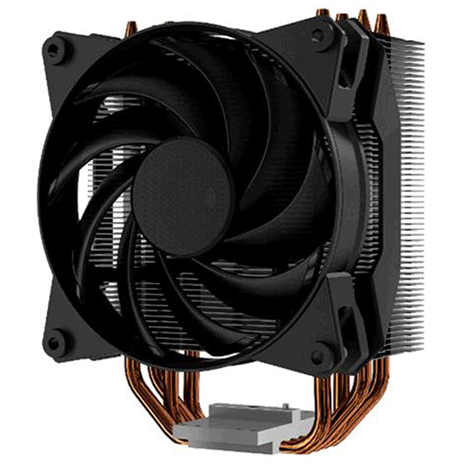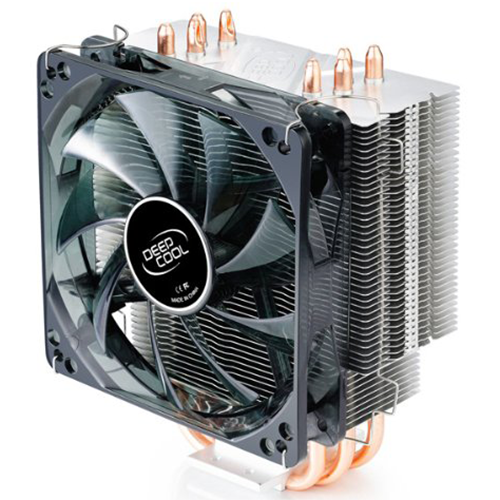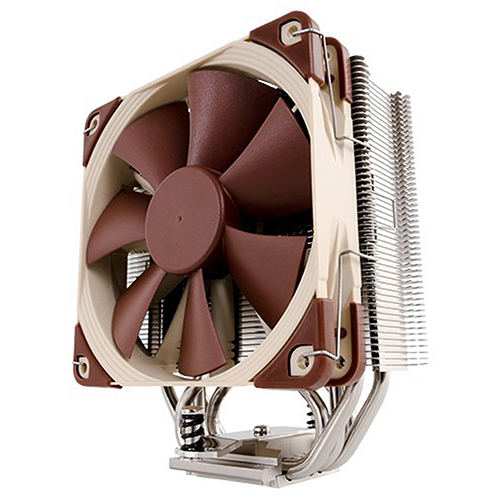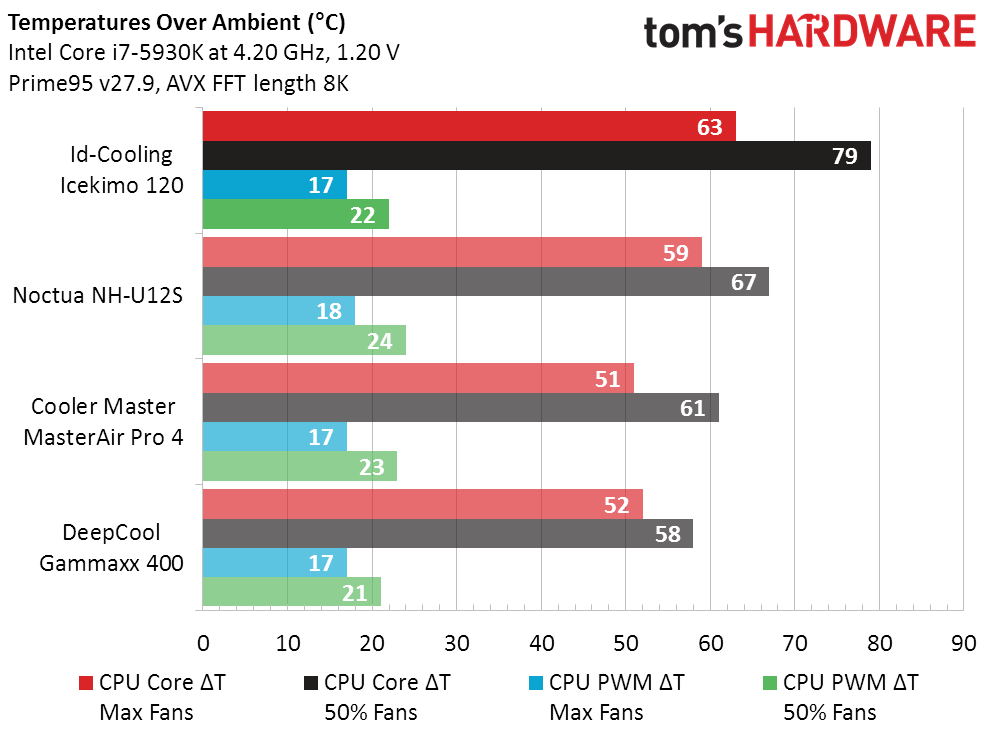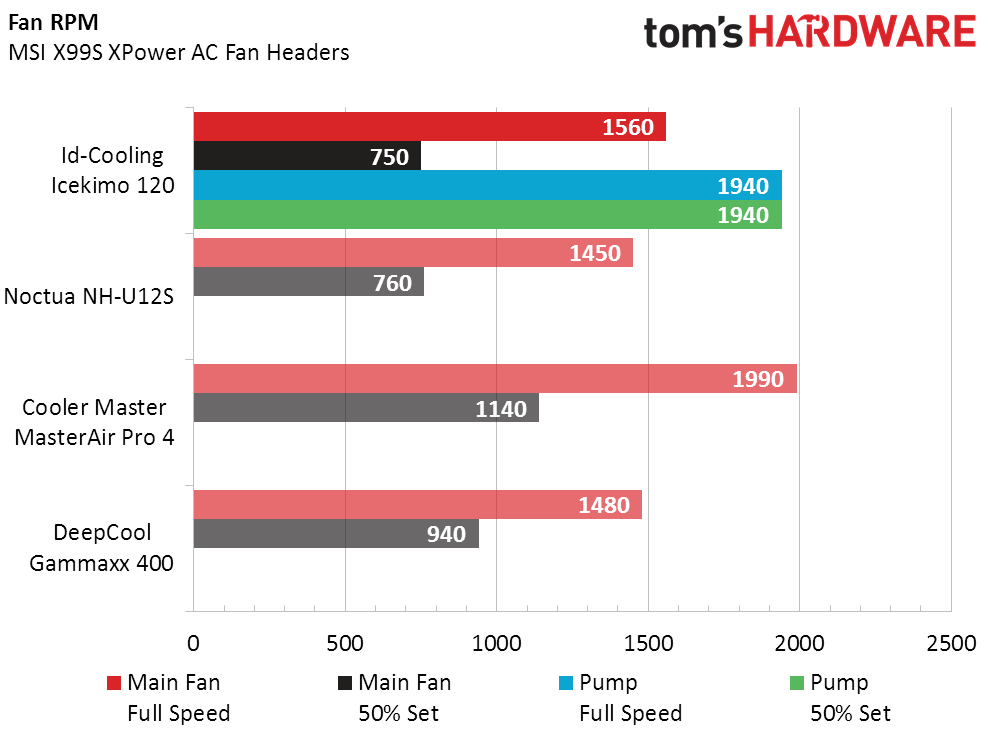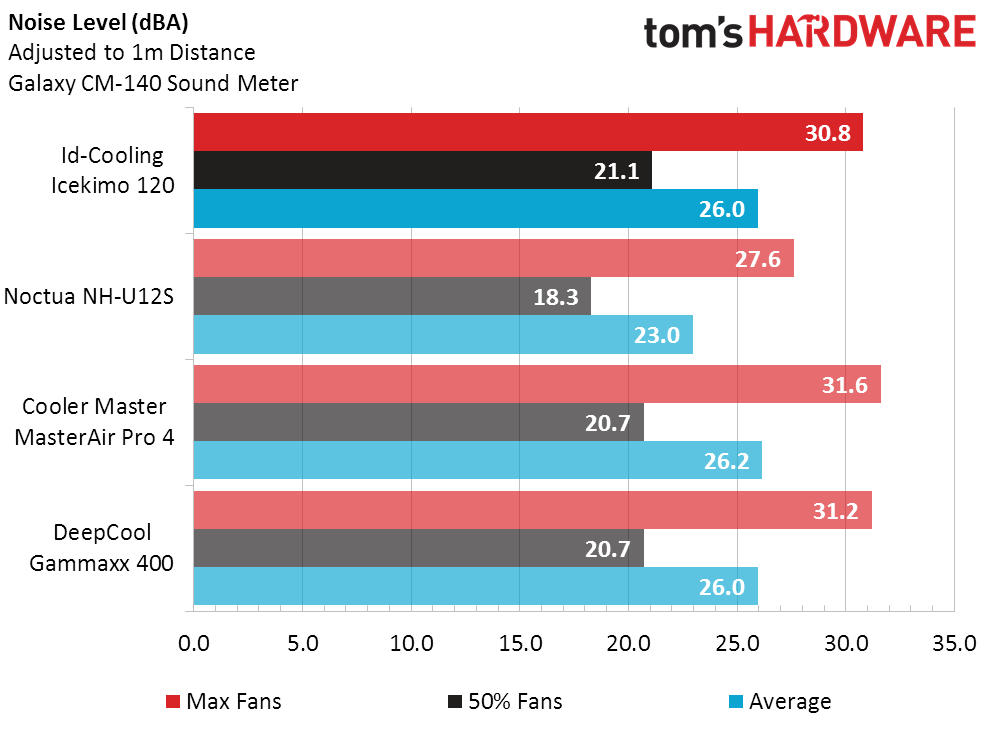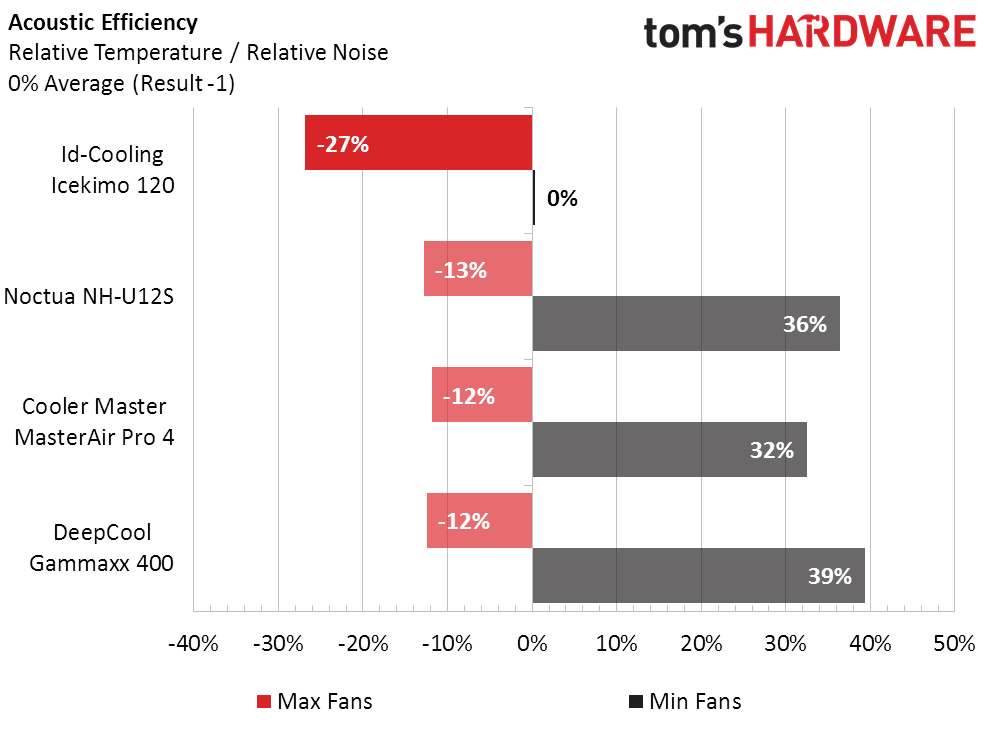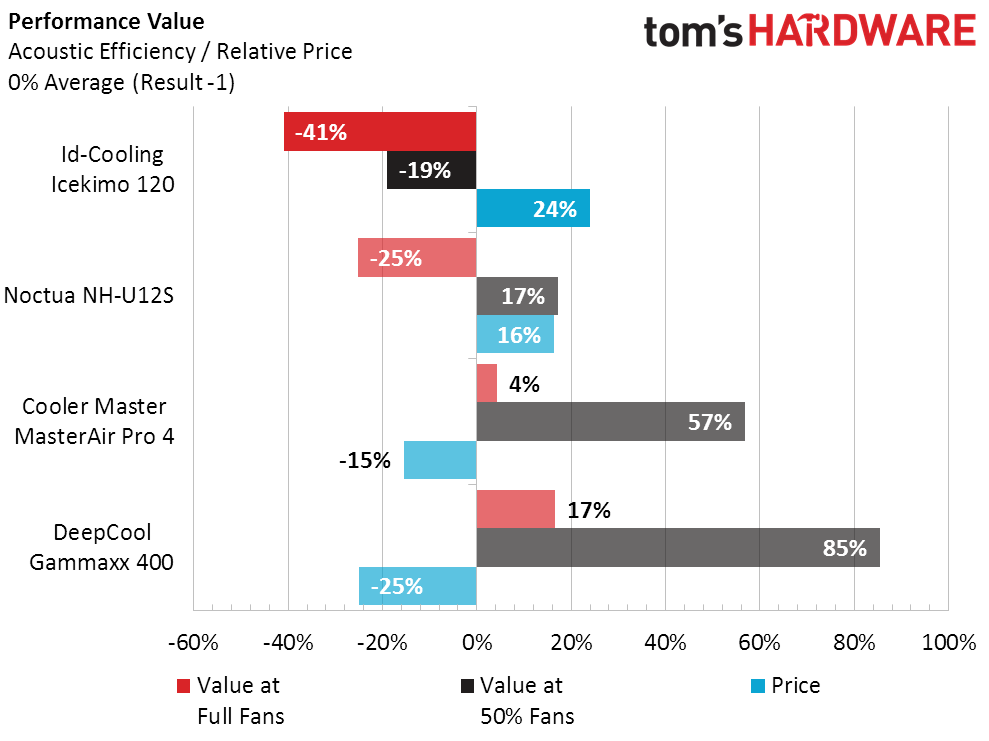Early Verdict
Id-Cooling’s Icekimo is powerful enough to tackle big cooling jobs and small enough to fit many compact cases. The only truly compact liquid cooler to compete against our recent big-air models, the caution of liquid-cooling competitors suggests that it will likely remain unchallenged.
Pros
- +
Very Compact design
- +
Very light weight
- +
Low to moderate noise at various speeds
- +
Powerful enough for a lightly overclocked Haswell-E CPU
- +
Illuminated pump cover and fan for show builders
- +
Available in both white and black finishes
Cons
- -
Doesn’t keep up with big-air coolers of same fan size
- -
Kink-free installation requires 70mm+ clearance above CPU
Why you can trust Tom's Hardware
Most manufacturers aren’t gutsy enough to send a compact cooler for our big system test, since radiator size looms large in cooling capacity. Compact systems that lack the space for “Big Air” CPU cooling towers are probably the best market for small liquid units, but Id-Cooling’s submission could have one advantage: Any unit that can handle the thermal load of the overclocked Core i7-5930K in our CPU cooler testing beast should be more than adequate to cool your quad-core compact desktop.
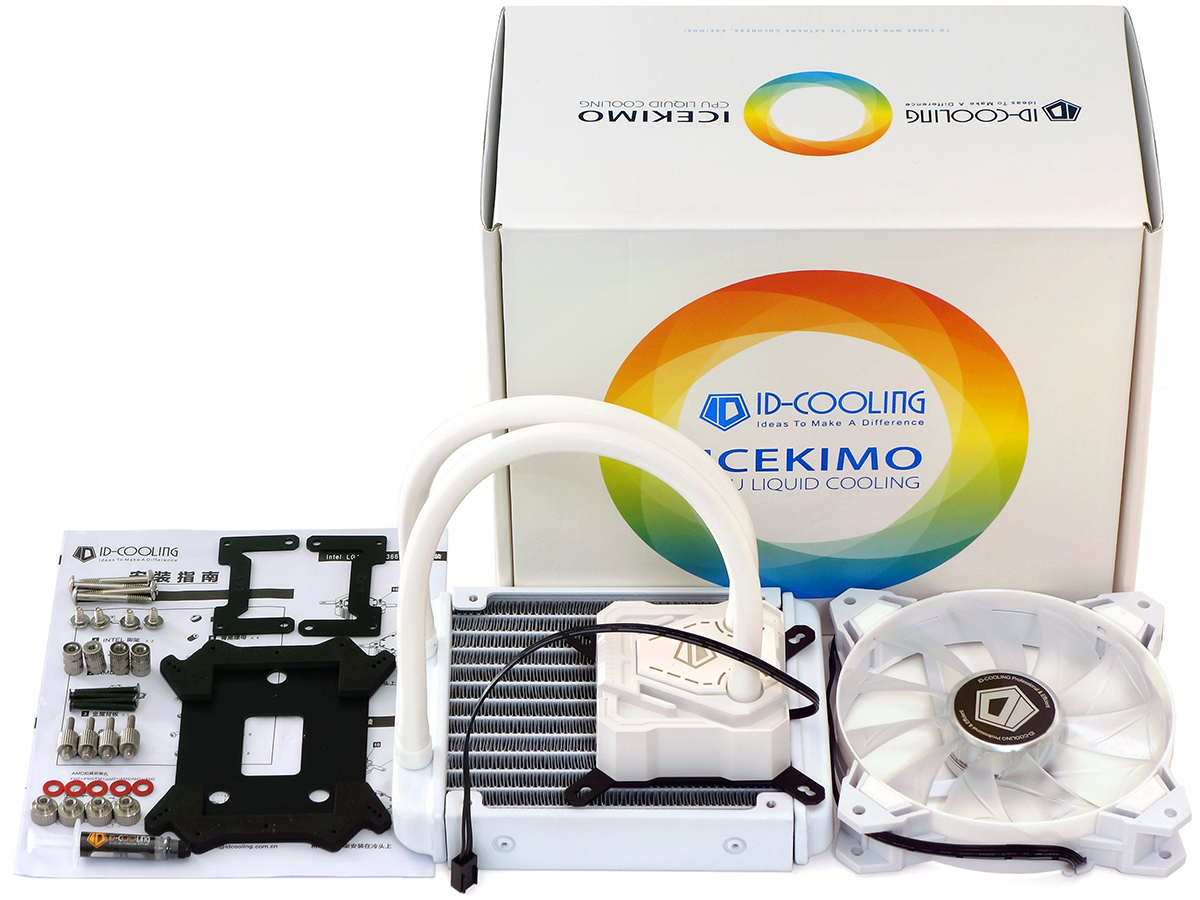
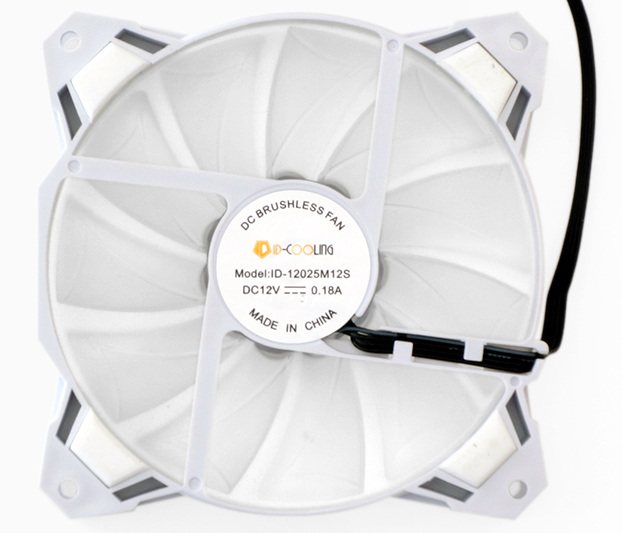
The Icekimo 120 is a compact 119x154mm, although its 26mm radiator thickness is fairly common. You’ll also need around 70mm or more of space above the CPU, since there aren’t any angle fittings on its non-reinforced rubber tubing. The Icekimo includes factory installed square-ILM brackets to fit Intel’s recent desktop LGAs, a pair of AMD brackets that replace a motherboard’s clip brackets (assuming they have the standard four-hole mounts), a semi-universal support plate for non-LGA 2011x motherboards, a set of fan and radiator screws, threaded standoffs and studs that fit the support plate, a separate set of studs to fit LGA 2011x integrated support plates, insulating fiber washers for the non-2011x standoffs, a set of nuts to secure the pump to the standoffs, and a small tube of Id-Cooling’s thermal paste.
Designed to mate with a CPU’s heat spreader, the Icekimo’s pump base is finely machined and extra flat. The factory installed Intel brackets are not drilled for the ancient LGA 775 standard, though the support plate for the back of the motherboard (oddly) is.
The Icekimo’s pump lead has a three-pin connector, while the fan has four leads and supports a motherboard’s PWM-based speed control.
While LGA 2011x users can screw the appropriate standoffs directly into the motherboard’s support plate, everyone else will need to hold the kit’s multi-format support plate on the back of their motherboard, push the threaded pins through the board’s cooler mounting holes, add a fiber washer over the exposed end of each stud, and then screw the other set of (hollow) standoffs all the way to the bottom, until the support plate is firmly secured. Both methods result in a similar number of exposed threads onto which the nuts will be added.
After applying thermal compound to the CPU, the pump slides over the Icekimo mounting kit’s exposed standoff threads and is secured with nuts. In order to maximize airflow over our motherboard’s voltage regulator heat sinks, I left the case’s 140mm fan on the rear panel and added the Icekimo cooling system to its top-panel mount. The case retains positive pressure due to its two intake fans and the lack of rear-panel exhaust on the test machine’s graphics card.
Since I haven’t tested any 120mm liquid coolers on this machine, I’m comparing it instead to three tower-style 120mm CPU coolers. The air-cooled advantage, in this case, is that the sinks are thicker and feed exhaust directly into the case’s exhaust fan. The disadvantage of tower-style coolers is that most 120mm models require greater than 6” (152mm) of internal clearance. Because Id-Cooling opted to face off against coolers of this size, we retain the hardware configuration from previous big cooler reviews.
Get Tom's Hardware's best news and in-depth reviews, straight to your inbox.
Test Results
The Icekimo appears to struggle to keep our overclocked Core i7-5930K cool at half fan speed, but the motherboard itself has been configured to allow a 115°C throttle point. We’ve seen it reach that on 92mm coolers, and the Icekimo is able to fit into even less space than those failed offerings.
The Icekimo’s 3-pin pump isn’t adjustable on this motherboard, but our noise level chart will show that its fan makes most of the noise.
With the fan at half speed and the pump at full blast, the Icekimo’s noise is barely perceptible. The 30.8 decibel reading at full fan speed sounds like a muffled roar, but still isn’t terrible compared to most other 120mm coolers. I suggest putting it on the back of the case, facing away from you, and using the motherboard’s automatic fan control to bring noise back down to barely perceptible levels under normal loads.
Air coolers have no pumps to make extra noise, but only the NH-U12S was substantially quieter than the Icekimo 120. In this comparison, its lower acoustic efficiency is primarily affected by its higher temperatures.
The most important thing to keep in mind when comparing the performance value of the Icekimo to its air-cooled counterparts is that the compact liquid cooler is able to fit far smaller cases. Most slim cases have room to add a 1” thick radiator to a 120mm fan mount, and those buyers will find that the slim air coolers that also fit their cases don’t even have the capacity to cool our test system’s overclocked Haswell-E CPU.
When you buy a liquid cooler, you pay for the pump. Adding that to the fact that the Id-Cooling Icekimo isn’t big enough to keep up with the thicker 120mm tower-style air coolers, and you’re left with something that looks like poor value. But once again, it’s important to remember that the reason we don’t test slim air coolers in our big system is that they can’t keep our big CPU below its thermal threshold.
What this means, overall, is that Id-Cooling succeeded in proving that its little Icekimo liquid cooler is powerful enough for a big overclocked CPU, but that the only people who will find it to be a better option than big air are those who can’t fit a big-air cooler. Had the firm included a set of narrow-ILM notches in its similarly-spaced AMD mounting brackets, it could have been a perfect mate for my X99E-ITX/ac and one of my old HTPC cases.
MORE: Best Motherboards
MORE: How To Choose A Motherboard
MORE: All Motherboard Content
-
Math Geek could be an interesting option for a small build for sure. would love to see it with an i5 and a mini 1070. could be interesting in a small htpc/gamer buildReply -
Onus If you have room for a 120mm air cooler like the Gammax 400, get that. If you don't have room for such a large cooler, this one is a good choice if you're limited to a single 120mm radiator.Reply
So, is this an accurate synopsis? -
JackNaylorPE With even ITX cases having room for large coolers, I don't see the point given the noise and temp penalties.Reply -
anbello262 Reply19171935 said:With even some ITX cases having room for large coolers, I don't see the point given the noise and temp penalties.
Fixed that, a bit more realistic now.
It makes sense when you want the smallest possible machine. There are some ITX cases that are only slightly larger than a console (while there are other that are as large as a mATX case) -
photonboy It would be nice to include a chart where the temperature is the SAME under load so we can compare NOISE.Reply
What matters to ME is:
a) is the cooler GOOD enough for my CPU? and,
b) what will the IDLE and LOAD noise be?
PUMP NOISE can also be annoying despite showing a low dB in the same way a small, whiny fan can be lower dB but annoying. They can also worsen over time, and AIO have roughly a 5-year life just FYI (due to tube permeation of the liquid).
So I'd avoid liquid coolers unless absolutely necessary. Scythe has a new cooler for normal sized ATX cases: https://www.pcper.com/news/Cases-and-Cooling/Scythe-FUMA-SCFM-1000-may-be-next-favourite-heatsink -
JackNaylorPE You nailed it, if you want the smallest possible machine and that instead of performance is your priority, you can meet that goal with a console or a laptop.Reply
Each increment of shrinkage brings compromises in not only in cooler / GFX card sizes but in case cooling ability as well as room to get in there with human sized hands to route wires and grab that dropped screw. If performance is a priority, you buy the ITX 14" x 9" x 15" case (1.09 cuft) that has more fan mounts, fits larger GFX cards. That's always going to be a bigger case than the 0.5 cuft one using IGP / 65 watt GFX card and a non K series processor. The "free bonus" that comes with the case that fits that big 1070 / 1080, assuming that you have selected a well designed case with enough case air flow, is that the larger size also allows the bigger cooler.
I just don't see the point in ever giving up performance for case size. If case size smaller than ITX is important and performance is not, a console will fit the bill. Or, again, with today's 10xx mobile GPUs which give up very little compared with past generation cards, so will a laptop.
Back in the 90s we were asked to do a fair amount of small builds so users could easily take to LAN parties. But when the internet came along and replaced the network cable for multi-player gameplay; the need to relocate became unnecessary. That being the case, the appeal of a case with an 80 sq.in. desktop footprint with performance limitations versus one with a 125 sq.in footprint with none just escapes me. -
anbello262 Reply19172594 said:You nailed it, if you want the smallest possible machine and that instead of performance is your priority, you can meet that goal with a console or a laptop.
You're going from one extreme to the opposite one. If i was looking for a mini ITX build, I would be looking at Size/Performance ratio, and looking for a sweetspot for my use scenario.
Therefore a console wouldn't fit the consideration, but neither would something that supports a full length video card AND a big air cooler at the same time.
I want a very small ITX case because I need to relocate often (I live in 2 different places, so I basically move once a week).
A laptop doesn't have what I'm looking for (either way too expensive, or not enough performance/cooling at the same price). I want a desktop PC I can fit in my backpack. Most of the builds I've been seeing also weight about the same as a powerful laptop, and can fit a half length 1070.
So I would be one of the potential customers of this specific cooler. With this cooler, I can also fit a K processor and OC it quite a bit.
If performance was the main priority, I would just go mATX or full sized tower. But it is not, size comes first, but performance is also there, just in a second place. In the third place, there is price.
Laptops are usually way too expensive compared to a small mini ITX build (same specs), and there are upgradeability concerns. Different enough to not fit the bill. I would be also paying for a battery, monitor and peripherals that I wouldn't use most of the time. I considered one, but I would have ended up paying about double the price of an ITX build.
Consoles are not to even be considered, they are such a completely different thing, it doesn't even deserve mentioning here. A PC is a lot more than a "Gaming Box", and even in the gaming department the differences are too big. It's like comparing a 3DS to an XBOX.
Also, I really don't think that "building difficulty" is important enough to even consider, especially when making a "niche" build. I'm going to spend a day or two building it, but years using it, after all. I understand that you might be concerned with it, when making lots of build for other people, but that's certainly not my case.
What I'm trying to say is that this is NOT meant to be a mainstream product. This is a niche product, and therefore you should look at the intended market when assesing the product. -
Crashman Reply
Yeh, that's good. This is only a "great" solution if you don't have room for big air.19171690 said:If you have room for a 120mm air cooler like the Gammax 400, get that. If you don't have room for such a large cooler, this one is a good choice if you're limited to a single 120mm radiator.
So, is this an accurate synopsis? -
BulkZerker "Yeh, that's good. This is only a "great" solution if you don't have room for big air."Reply
From what I've read its a good solution even if you do have room for "big air". -
Crashman Reply
It could be, but you could just get a Gammaxx 400 if you had room for it.19176899 said:"Yeh, that's good. This is only a "great" solution if you don't have room for big air."
From what I've read its a good solution even if you do have room for "big air".
